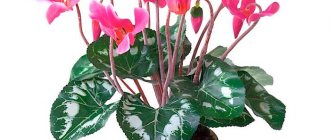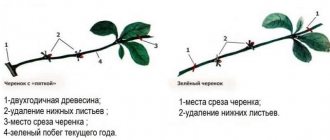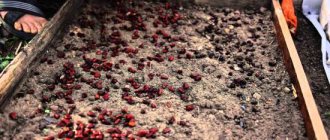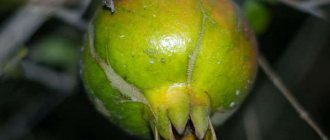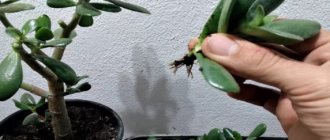Features of the plant
Pomegranate is a small tree with juicy and sweet fruits. The plant is cultivated not only for its fruits, but is also used in the garden as decorative hedges with flowers of various colors. At a young age, pomegranate has very flexible shoots, which allows you to create absolutely any shape from the trunk and crown, which is ideal for bonsai.
The tree reaches a height of up to 5 meters and often has sharp spines at the ends of its branches. In the tropics this plant is evergreen, but in subtropical climates with cold winters the leaves fall off in the fall. The first flowers and fruits appear at 3 years of age. Many varieties, with proper care, can bloom all year round.
This is a self-pollinating plant, and from the moment of flowering to the full ripening of the fruits, 4-5 months pass. For normal fruit ripening, the temperature must be at least 25 degrees.
Advantages of the method
Cuttings are a method of growing plants that are used for various crops, including pomegranate.
The use of cuttings, compared to other methods, has a number of advantages.
A cutting (chubuk, shoot) is a small shoot, it grows quickly and in a year or two turns into a small tree, delighting with wonderful flowering and first fruits. When planting a chubuk tree from a well-known tree, they know in advance the quality of the expected fruit, the care requirements and the behavior of the plant.
How to care for young sprouts
Small sprouts require a temperature of +18 to +25°C and lighting for 10-12 hours a day.
If planting was carried out in the fall, the plants need to be illuminated with special phytolamps. Its minimum operating time is 2 hours in the morning and evening. In winter, the sprouts are constantly illuminated throughout the day.
Pomegranate needs moderately humid air. The heat from the radiator can destroy young plants, so place bowls of water next to the container, use a humidifier, or sometimes spray the sprouts with a spray bottle.
Water as needed: ideally when the soil dries to a depth of 2-3 cm.
The sprouts are distributed into a separate pot after 2-3 leaves appear on them. Use the same soil as when planting grains. At the same moment, the sprout is pinched so that the roots become stronger and develop better.
There is an opinion that pinching is best done a month after transplantation. This stimulates the rapid development of new branches and makes the crown round.
Watering and humidity
At first, proper watering is very important, because the cutting loves water very much. The main thing is to water on time and not to overdo it with water. If you plant a sprout in winter, then at this moment you do not need to water it very much (once a month).
As soon as February passes, you need to gradually increase watering; you will need to water the plant twice a month. In addition, you will need to fertilize the plant. It is best to water only when the top layer of soil has dried out a little, this indicates that the water has dropped and the roots no longer receive the required amount of moisture.
On hot days, it is best to spray the plant every day, so the leaves will receive moisture and not dry out, and dust will not settle on them.
Secrets of caring for indoor pomegranate
Lovers of indoor potted flowers value the decorative dwarf plant not only for its exceptional external qualities, but also because caring for an indoor pomegranate does not require special skills. If you follow some rules and create a minimum of conditions for the dwarf shrub, it will reward you with lush flowering from November to the end of January.
In summer, indoor pomegranate “lives” perfectly in the garden or on the balcony. To avoid leaf burns, do not plant it in the sunny side. The best place is the eastern or western side shaded by trees.
Caring for indoor pomegranate at home. Photo
During the hot season, the plant requires abundant watering
and spraying.
In order for the mini-shrub to increase the number of green leaves for caring for indoor pomegranate at home, it is better to choose nitrogen fertilizers
, and in order for fruits to appear - phosphorus additives. You can choose a mineral mixture at any specialized flower shop.
The loss of leaves from a plant may not always be a sign of poor health. Before winter, pomegranate sheds its leaves, freeing itself from dense greenery. At this time it is necessary to feed
its potassium fertilizer.
Caring for indoor pomegranates is different for adults and young ones. Young plants need watering more often, while older plants can be watered once every 10 days.
For wintering
A non-hot place, even a glassed-in loggia, is better suited. An important requirement is the absence of drafts and very low temperatures;
When transplanting
plants should choose black soil with the addition of turf. Complex soil is ideal;
drainage at the bottom of the pot into which the plant is transplanted.
so that the roots do not rot.
Where in Russia can you grow pomegranate?
These trees are successfully grown in Turkey, Azerbaijan, Georgia, and Abkhazia. Pomegranates grow here and there in Russia - in the south of the Krasnodar Territory, in the Crimea, the Azov region, and smaller varieties have taken root in the republics of the North Caucasus, in the warmer foothills. The most daring gardeners are trying to adapt new, more cold-resistant varieties of this crop in the middle zone and Moscow region.
How to choose a place for pomegranate in the garden?
When choosing a site for planting pomegranates, you should give preference to flat terrain. If there is a slope, it should be directed towards the south. Also, this area should be well protected from winds.
Pomegranate is undemanding to soil; it grows well on crushed stone, sandy loam, rocky and even solonetzic soils, although loamy and alluvial soils are considered best for it. Of course, it bears fruit better on fertile, moisture-absorbing, well-drained soils than on excessively saline and waterlogged soils.
Pomegranate is relatively drought-resistant, but at the same time tolerates high soil moisture.
Purchase of planting material
You can purchase pomegranate seedlings or seedlings in a special store. Make sure you buy a variety whose fruits are edible so you can enjoy them later. However, if you have friends who have a pomegranate tree, you can also take seedlings from this tree from them.
Method for rooting sprouts in water
The method of rooting cuttings in water is used at home, when growing plants, flowers, and shrubs. Plants such as grapes, roses, chrysanthemums, begonias, currants, and gooseberries reproduce well in this way. When propagated by this method, you can visually observe the viability of the cutting and the development of its root system; if necessary, using special means, help the plant in further development and growth.
Materials for the procedure
After cutting the cuttings, the lower cut is dipped into a dry mixture of Kornevin and crushed activated carbon (in equal quantities), the excess adhering mixture is shaken off so as not to cause the death of the planting material. The cuttings are placed in a bowl with water in a warm, bright place. It is advisable to take glassware for cuttings, made of white glass.
Polyethylene dishes are light, unstable, and quickly tip over, which causes unpleasant troubles and damage to the emerging cuttings. Through the transparent glass, the development of the roots is clearly visible. If the water becomes cloudy and mucus appears on the roots, they must be carefully washed with warm water and filled with fresh, warm, chlorine-free water.
Period of appearance of roots
Within a week, the buds of the shoots will begin to turn green and swell, and by the end of the week the first white roots will emerge. Over the next week, the development and growth of the root system will begin.
If there are weak, thin roots, it is clear that the root system is not developing enough, the shoot is not viable, and may die during transplantation. It is necessary to dilute Kornevin in water at the rate of 1 milliliter per 1 liter of warm water and keep the planting material in this solution for 12 hours, then put it back into clean water. When a well-developed, dense root system is formed, the shoots are transplanted into a pot in a permanent place.
Description and history of selection of the Haas avocado variety, application and how it differs from the usual oneRead
Planting in prepared soil
After 3-4 young shoots with leaves appear, the cuttings are transplanted into separate pots without damaging the root system with an earthen lump. Drainage is poured into the bottom of the pot. The pots are placed on the windowsill (provided that the window sills are wide), in the room on the south side; In bright sunshine, the plant is shaded so that the sun's rays do not burn the leaves. You can place the pot in a place that is well lit, opposite a window - this is the best option for the development of the plant.
Methods for growing in open ground
Is it possible to grow a tree in a garden or country house and how to do it? There are plenty of ways to grow pomegranate trees. It is bred from seeds, cuttings, sprouts, using layering and grafting. But each of them has its own characteristics.
From the seed
The fruit to be pitted is chosen to be large, absolutely ripe, with good taste characteristics. Only then can you be sure that the daughter plant will be no worse, but provided that high-quality care is provided for 2-3 years.
- Peel the pomegranate seeds and immediately place them in a container with a stimulating solution for 10-12 hours.
- Prepare a pot for planting and soil.
- Distribute the seeds evenly over the surface of the soil at a depth of 1 cm. Then sprinkle with a 1.5 cm layer of soil.
- It is necessary to create greenhouse conditions.
- Provide seedlings with regular watering with warm water and access to fresh air.
- Remove the greenhouse as it grows.
- When the sprouts stretch 3-5 cm upward, they will need picking.
- After 3 months, repeat.
- Leave only strong, healthy shoots to obtain a pomegranate tree.
Cuttings
This is the most popular method among gardeners. It gives an almost 100% harvest guarantee.
- In the first days of spring, we prepare the cutting: we take the middle of a two-year branch about 15-20 cm.
- The presence of 2-3 kidneys is a must.
- Soak for 2-3 hours in a biostimulator solution.
- Plant the prepared cuttings in a container with well-warmed soil to a depth of 10 cm. One internode should remain on top.
- Greenhouse conditions should be created to obtain the desired result.
- Do not forget to ventilate and water the cuttings.
- After 3-4 months, transplant the sprout into a large container for further germination.
- A year later, in late spring, you can plant it in the ground.
By layering
The method of propagation by root shoots is used in cases where there is a need to rejuvenate the pomegranate tree. Then carefully separate the strong root shoots and plant them in open ground for further strengthening.
Important. The procedure should be carried out in the spring
Then by winter the sprouts will become strong and flexible, thus withstanding the shelter for the winter.
Vaccination
There are several types of pomegranate grafting:
- splitting the cuttings;
- under the bark;
- budding, which involves grafting with a sleeping eye.
The first two methods are performed in early spring, around March. But the last one is at the beginning of autumn. The cutting should be selected from a young plant, 15-20 cm in size. It is better to insert it into the tree from the north side, so the sun's rays will not penetrate the splice site. The first flowering of pomegranate will occur in 3-5 years.
From a sprout
The principle of the method is quite similar to the seed method. Carefully plant the finished sprout in a container with prepared, nutritious soil. We create the right conditions for further growth - this is temperature and humidity in the room, watering, spraying. After a few months, depending on the size of the plant and the time of year, plant it in the ground.
Landing in the ground
Dear friends, after 3 months the young growth has taken root and grown, it’s time to transplant it to a permanent place of residence. To grow a healthy tree, I looked in which container it would develop faster.
It turned out that the root system of the pomegranate is similar to a washcloth and is located closer to the surface.
This means that a wide and shallow ceramic pot is ideal.
Landing rules.
- Before planting, I advise you to wash the new container with a disinfectant (liquid laundry soap 1 ml + manganese 5 crystals + 1 liter of water).
- I put a thin layer of drainage on the bottom.
- I put 3 branches rooted in the tablet next to each other, so the crown will be more beautiful and luxuriant.
- I fill it with soil disinfected in the oven (1 part perlite + 2 parts turf + 1 part humus).
- I pour the soil without compacting it.
- I place a 5 liter greenhouse bottle over the young animals.
- I place it in a warm place for 1 month.
How to continue to care
Dear readers, transplanted small trees require daily attention.
- Once a day I open the greenhouse for ventilation.
- I cover the window with tulle if the sun is strong so that the seedlings do not get burned.
- I loosen the soil after watering.
- As soon as new buds begin to grow, I remove the greenhouse and take it out into the fresh air for hardening.
An important point is pruning homemade pomegranate; learn the intricacies and prepare in advance for a serious procedure.
Watering and air humidity control
After removing the greenhouse, I regularly spray the bushes with warm water, especially in dry and sunny weather, and do not forget to carry out water procedures to maintain normal humidity.
- The subtropical bush prefers well-moistened soils; if the earthen ball dries out, the root and crown will die immediately.
- I water it once every 2-3 days with plenty of warm, settled water; for pomegranate, you can use the root option of moistening the soil and through a tray.
- When the pomegranate began to bloom, irrigation was replaced with foliar feeding; I will go into detail below.
Fertilizing
An important point in the development of green young animals is timely feeding with microelements and minerals. I recommend using this fertilizer application scheme.
| Fertilizer | Application time | How to cook | How much for 1 bush |
| Agricola | Once every 7 days | cap + 1 liter of water | 300 ml |
| Mullein | After mineral 10 days | 1 tbsp. l. + 1.5 liters of water | 500 ml |
| Chicken manure concentrate | Throughout growth, once every 2 weeks | 1 tsp. + 100 ml of water, leave for 14 days in a closed jar, dilute in a ratio of 1:10 with warm water. | 2 glasses |
| Foliar sprays | When 1 flower appears | 1% boric acid solution (10 g + 100 ml water) | 2-3 times during flowering |
Author's note
Natalia Papanova
Blog author
Before each application of the nutrient mixture, moisten the soil in the pot so that the tender roots do not get burned.
Transfer
I will draw your attention to transplanting decorative pomegranate.
- A new plant requires replanting when 10-12 leaves appear.
- For 5-6 years I have been replanting in March every year.
- I carry out the following transshipments once every 2-3 years into a container 10-20 mm wider.
- Before changing the pot, I dry the earthen ball for 2-3 days, this way the roots are less damaged.
Teenagers for transfer to a new place
Shaping and trimming
Dear gardeners, to form a bush you need to take secateurs treated with alcohol, garden pitch, and a new blade.
Trimming sequence.
After 4-6 months I begin to form a crown.
- First, I combine 3 bushes into 1 trunk, twisting them into a bundle.
- All green mass must be cut off with pruning shears so that no stumps remain.
- I leave 5 branches at the top, from which I will gradually form a beautiful spherical crown.
- I clean the cut areas to a smooth surface with a blade and cover them with varnish.
Watch the video for step-by-step instructions on pomegranate pruning.
Pomegranate after trimming
Not interested in pomegranate? Hurry up and watch the process of growing an avocado from a seed; you can conduct an experiment on cultivating a subtropical plant.
Suitable conditions
The south side of the room is suitable: the pot is placed on the windowsill; in the summer you need to make a shelter for it.
- In order for the seedling to start growing quickly, it should be soaked before planting;
- the soil is fertilized and then well moistened;
- drainage is required;
- The last watering of the cutting occurs in early October.
When propagating an exotic plant, it is important to follow these simple rules:
- The cuttings are taken from an adult indoor plant that has repeatedly bear fruit.
- In the summer, it is advisable to use semi-lignified shoots, and with the onset of winter, completely woody shoots.
- The cuttings are prepared with 4–6 buds, and the lower part is planted at a certain angle in moist soil consisting of sand and peat mixed in equal proportions, to a depth of no more than 3 centimeters.
- The cuttings are covered with a plastic bottle with the neck cut off or a glass jar.
- The shoots are kept in a moist environment and ventilated regularly.
- Before direct planting, the cuttings are treated with a rooting agent.
We invite you to familiarize yourself with Green tomatoes for the winter - 10 delicious recipes for preparing green tomatoes
After 3 months, the strengthened seedlings are transplanted into separate pots. Flowering occurs very quickly, but in the first year it is recommended to cut off the flowers completely.
Despite all the unpretentiousness of the plant, even in apartment conditions it is susceptible to the development of various diseases, the most common of which is spider mites. To combat the pest, the pomegranate is periodically sprayed with garlic tincture.
But it is important to protect the soil with film during the procedure.
If yellowing and falling leaves are observed during the growing season, then most likely the plant is infected with whitefly, which feeds on pomegranate juice. To combat the pest, you can use the store-bought product “Derris”, which is applied several times for better effect.
In the case of pomegranate, two propagation methods are available. The first of them is seed, more complex and less effective. You should use it only if you have at your disposal large, selected seeds taken from high-quality fruits. Only in this case, when using the seed propagation method, there is a high chance of getting a plant similar in characteristics to the mother shrub. But most often, home botanists and breeders use a different method - vegetative.
Caring for young shoots
Despite the fact that this is an unpretentious plant, the growing conditions for pomegranate must be properly organized, as this will allow you to get a good harvest of fruit. After planting the seeds, the first shoots begin to hatch within a few weeks. It is during this period that it is necessary to provide optimal conditions for the rapid formation of young shoots
It is very important to know what a pomegranate sprout looks like so as not to confuse it with weeds whose seeds could remain in the soil
When the first shoots appear, heat and humidity play an important role. It is strictly forbidden to water the soil, but if the soil is dry, you can spray it a little with a spray bottle.
Seedlings with 2-3 leaves are transplanted into separate pots. Pomegranate seedlings are planted in the soil, to prepare which you need to mix:
- leaf humus - 1 part;
- sand – 0.5 parts;
- turf – 2 parts;
- peat – 0.5 parts.
Pomegranate has a superficial rhizome, so the tree can grow well in small containers. The most important thing is to ensure good drainage. Caring for young plants involves abundant regular watering, which is carried out as the surface layer dries. Excess water from the pan must be poured out.
If the plants were planted in winter, then they require additional artificial lighting, otherwise the pomegranate sprout will become very elongated or will not grow at all. When transplanting seedlings, it is recommended to tip them a little so that they stretch less. Then, after the third pair of leaves appears, you need to pinch the top, thus stimulating growth with two crowns.
Subsequently, these two branches need to be pinched at the level of the 3rd pair of leaves. Without this, the pomegranate will simply stretch upward for a long time and remain fragile. The first flowering can be at the age of 10 months, provided that the tree has enough light.
Sprouts prefer bright light, but on hot days it is best to create a little shade to avoid burning the leaves. It is recommended to place the pot on a south-facing window. Periodically you need to take it out into the open air. In winter, it is recommended to place the plant in a well-lit, cool place.
During the growing season, it is recommended to maintain the temperature at 20-25 degrees, and closer to autumn it should be lowered slightly. The young tree needs to be replanted every year, choosing a slightly larger pot each time.
Planting process
In order for the plant to germinate well, it must be planted correctly. The first thing you need is to purchase an oblong clay vessel.
After this, fill it with a special mixture, described above, and make several holes. The distance between the seedlings should be no more than 5 cm. After this, immediately wrap everything carefully with film or other material that does not allow moisture to pass through.
This method is necessary to ensure that the cuttings are always in a humid and warm climate. Under such conditions, they will grow much faster and produce the required number of shoots for optimal development. Don't forget to ventilate every day. This is necessary so that the plant does not take in a lot of moisture.
Transplanting into a pot
After a few months, when the cuttings have developed well, each seedling must be transplanted into a separate pot. It is also best to choose a clay pot, because such materials do not affect the root system in any way and do not release toxins into the soil.
When you replant, carefully monitor the entire root system so as not to damage it. You cannot cut or tear off the roots, this will lead to rotting and the plant will die.
Description of dwarf decorative varieties of pomegranate
In nature, the pomegranate tree grows up to 5-6 meters. However, special decorative varieties are grown at home, which, due to their size, are called dwarf. They generally grow between 80-120 cm. The leaves are small, oval-shaped with a pleasant gloss. They have a bright light green color.
An interesting detail is that the foliage almost constantly changes its color.
When the growth period begins in the spring, they are more saturated bronze tones, and during the summer they manage to acquire rich green tones. By autumn they turn yellow, like most of the trees we are used to.
Short description
Pomegranate belongs to the Derbennikov family. This perennial grows in subtropical regions of Europe and Asia. Garden and ornamental varieties have been bred for home cultivation. The height of the dwarf pomegranate does not exceed 1 m. It is grown in two forms - bush or standard.
The pomegranate tree is a deciduous plant with a superficial root system. The area occupied by the roots is twice the diameter of the crowns, so the tree is highly drought-resistant. In nature, pomegranate grows on poor rocky soils. Cultivated varieties have inherited hardiness and unpretentiousness from their wild ancestors.
On a note!
To form a miniature tree of an attractive shape from a pomegranate bush, it is recommended to use Japanese bonsai technology.
The nuances of propagating pomegranate seeds
A houseplant like pomegranate can be propagated by both cuttings and seeds. For seed propagation, it is better to use seed material from specialized stores. When growing a houseplant from seeds purchased at a gardening store, the first flowers may appear in the first year, and fruiting may take place 2–3 years after planting the pomegranate.
.
Naturally, seeds from a fresh fruit can be used as seed material, which do not lose their germination quality for six months. Seeds are suitable only from large and fully ripened fruits. The plant is sown in April under glass, to a depth of half a centimeter.
For rapid seed germination, it is important to maintain a temperature within +25–27 °C. With the onset of the growth phase, when 2–3 leaves appear, the strongest shoots are transplanted into a separate container
As seedlings grow, they require proper care, which includes maintaining a comfortable temperature and regular watering.
Further care
In the future, the pomegranate is replanted for 3 years in a row, gradually increasing the pot to 4 liters, then - if the tree does not have enough space.
In order not to injure the roots, transplantation is carried out using the transshipment method. The pomegranate is not watered beforehand for several days. When the soil in the pot dries, it is turned over and the plant is removed along with the lump of earth.
How to grow indoor pomegranate from cuttings
The pomegranate tree is a tropical crop. To successfully cut it, you need to create a microclimate at home that is as close as possible to its natural habitat:
- High level of illumination. For high-quality flowering and fruiting in the dark, during prolonged cloudy weather, additional lighting is used.
- Increased air humidity. If the room is too dry, the plant is sprayed or the humidity is artificially increased. An indoor pomegranate can completely lose its decorative effect due to dry heated air and lack of lighting and become very stretched upward.
- Temperature range within +20…+25°C. At higher rates, the plant loses leaves and its vegetation slows down.
- Regular and moderate watering. The soil in the container should always be barely moist. During the flowering period, watering is reduced, but drying out the soil is unacceptable.
- Fertilizing the soil. Pomegranate responds well to regular feeding. For the formation of buds and abundant flowering, it requires nitrogen-phosphorus fertilizers, which are applied from March to mid-summer. In the second half of the growing season, mixtures with increased potassium content are used.
Pomegranate grows very quickly, its thin, broken branches create a chaotic, uneven crown, so the plant is pruned and shaped every year. Sometimes the procedure is carried out twice a year: before the beginning of the growing season and after the crop has faded, if there are no fruits on the branches.
Attention! The crown is formed as soon as 3–5 pairs of leaf blades grow, pinching off the growth points for further branching.
Problems when growing pomegranate
If you do not follow the care conditions, the pomegranate will almost immediately respond with external signs of deviation from the norm.
Falling and yellowing of leaves
If the leaves begin to fall off and turn yellow, this may be a consequence of 3 reasons:
- insufficient watering and humidity levels in the air;
- lack of fertilizers;
- location of the bush in a heavily shaded place.
Important! Pomegranate is a deciduous plant, so yellowing and falling off of flowers in the fall is normal.
Why doesn't pomegranate bloom?
This is one of the most common problems. The most likely reason is the lack of sufficient fertilizers
. They need to be applied at least 2 times a month during the warm season.
Pomegranate tree diseases and their treatment
Pomegranate diseases are associated with yellowing and loss of leaves, absence of flowers or ovaries. There is also a specific disease. due to the fact that the branches of the plant begin to peel off and die. It's called branch cancer
and is manifested by cracked bark, the appearance of foreign formations; In addition, the branches begin to dry out in large numbers. All diseased shoots should be removed immediately.
Pomegranate pests and their control
There are several dangerous insects for this bush:
- The pomegranate moth damages fruits by laying its eggs in them. Such fruits must be immediately removed and destroyed, and any insecticides are suitable to combat the butterfly.
- Pomegranate aphid - especially likes to feed on young, non-lignified branches. To combat it, the tree is sprayed with an infusion of tobacco and soap (ratio 10:1).
- Mealybug.
- Spider mites leave whitish webs on branches and leaves. These insects are also controlled using universal insecticides.
Pomegranate blossom (video)
Thus, you can grow pomegranate and expect flowers and fruits from it both at home and in the open ground. With proper care, the bush grows beautiful, spreading, with bright flowers, thanks to which it fits well into the design of any flower garden.
Diseases and pests
Inspect the plant regularly to notice signs of disease and the appearance of pests in time. Indoor pomegranate diseases occur due to improper care.
Powdery mildew
- External signs : leaves become covered with a whitish coating.
- Reason for appearance : a fungal disease occurs against the background of poor ventilation of the crown, high humidity and a sharp change in temperature.
- Treatment : wipe the leaves with a sponge soaked in a solution of soda ash (5 g/1 l of water + 10 g of liquid soap); if the crop is severely damaged, use fungicides such as Topaz, Skor, Hom.
spotting
- External signs : yellow-brown spots are observed on the leaves.
- Cause of appearance : waterlogging.
- Treatment : Replant the pomegranate in new soil. Before this, free the root system from the ground, remove rotten roots, and soak in a 1% solution of potassium permanganate. Water the plant according to the rules of agricultural technology.
Pests can spread to pomegranate from other indoor plants. If there are not many of them, collect them by hand. Use insecticides (chemicals) only when the crop is severely damaged.
Whitefly
- External signs : if you lightly hit the branches of a plant, a cloud of small white midges will rise up. They lay eggs on the back of the leaf. With a large number of parasites, the foliage turns yellow and curls.
- Treatment : spray the crown with garlic water (pour 3 crushed cloves of garlic with a glass of water and leave to infuse for 2 days). Fitoverm, Aktara - preparations for the chemical method of combating the parasite.
Aphid
- External signs : tiny green insects lay a huge number of eggs on the underside of the leaves. Due to the secretion secreted by parasites, the foliage becomes sticky and curls.
- Treatment : wash off the insects with a stream of water, lubricate the affected leaves with liquid soap, and after 10-15 minutes, bathe the plant in the shower. In advanced cases, use an insecticide: Iskra, Tanrek, Strela.
Shchitovka
- External signs: small brown tubercles appear on the leaves, under which the pest hides.
- Treatment: mechanically clean the pest's shields with a sponge soaked in soapy water. In case of severe damage, the use of a drug such as Aktara, Doctor, Zolotaya Iskra is justified.
Cutting options
To grow figs, green and woody planting material is used. Working with such cuttings has some differences. This must be taken into account when choosing a method.
In both cases, it is important to choose a suitable mother plant. It should already be blooming and bearing fruit.
This is a guarantee that child trees will also have this ability.
It is important to inspect the tree for disease and pest damage. If there are any suspicious spots or other symptoms, propagation is postponed until the plant is completely cured.
Lignified cuttings
Lignified cuttings have a hard but elastic bark. If you make a cut on it, you can see the green layer. The branches should not be too old or dry
It is important that there is no damage or signs of disease or pest damage.
The branches are cut into lengths from 15 to 25 cm. They must have at least three living buds. The lower cut is made at an angle of 45°, and the upper cut is made perpendicular to the branch.
The collected branches are placed in storage. If there is a basement, they are buried in sandboxes. Before use, sand is disinfected with a hot dark pink solution of potassium permanganate or by calcination in the oven (30-40 minutes at 180°C).
In the basement, planting material is stored at a temperature of +1…+5ºС. Once every 30 days, the sand is moistened with a small amount of cold water so that the cuttings do not dry out.
In March, the cuttings are cleared of sand. The lower part is shortened by 1.5-2 cm. Incisions 1.5 cm deep are made on the bark (in the lower part). The depth of such cuts should be such that the green epithelium is not damaged.
Green cuttings
Green cuttings are cut in spring. They must be absolutely healthy, well developed, without damage. The number of buds on high-quality pruning is at least 3-4. The branches are cut at an angle of 45º.
A juice resembling milk is released from the cut of green branches. Immediately after cutting, the planting material is left for 6-8 hours so that the sap stops.
The planting material is kept in a cool, dark place for 4-6 hours. Shallow cuts are made on the bark. After this, the cuttings are immediately rooted. The blanks form a root system in 1.5-2 months.
Bush formation
If indoor pomegranate is grown correctly, the plant will look beautiful and original. To achieve an aesthetically pleasing shape and a neat appearance, flower growers trim off excess shoots and form a bush. It is best to carry out pruning at the beginning of active growth time or before wintering - in spring and autumn.
Caring for indoor pomegranate at home involves pruning:
- dry twigs;
- fattening (not developing) shoots;
- branches that grow towards the depths of the bush.
External shoots, if they are healthy, should not be pruned. To get a beautiful, full-fledged bush, it is better to start pruning for formation on adult plants that are already more than 3 years old. Young pomegranates must be replanted indoors. This is done annually to replace depleted soil with fresh one.
How is the crown of a bush formed?
When you grow a tree yourself, you can easily shape its crown, realizing your wildest fantasies. For this purpose, home-grown pomegranate is subjected to regular pruning from the first year of growth. Trimming the plant forms a rather lush crown with a large number of skeletal branches. It is better to prune in February, which allows you to get new shoots that can bloom and even bear fruit with the onset of spring. When forming the crown, it is important to take into account that it is advisable to completely remove weakened shoots and cut the rest by half.
How to plant pomegranate at home
It is best to plant seeds in November or mid-spring. To begin with, the selected grains are placed in disposable containers up to 8-10 cm deep, maintaining a distance of 2-3 cm.
Drainage is poured into the bottom of the container. This could be pebbles, branches or sticks, broken bricks, small crushed stone. Drainage should occupy 1/4 of the container.
Seeds cannot be buried in the ground; it is best to press them a little into the ground with a pencil or stick. Each seed is immersed 1 cm.
The container is covered with film or glass to create a greenhouse effect so that the moisture does not evaporate too quickly. Afterwards, the container is placed in a warm place with a temperature of at least +25°C.
The soil is moistened as it dries using a sprayer. You can’t pour too much water - the seeds will rot or go deep and won’t be able to germinate. Immediately after the first shoots form, the container is moved to the windowsill. The temperature should be maintained no more than +18°C to avoid excessive stretching of the sprouts.
There is no need to immediately remove the bag or glass. The plant is gradually accustomed to dry room air over 3-5 days. After this, the seedlings are transferred to the usual growing regime.
Top dressing
This procedure is best done only a few times every 2-3 months. At first, so that the sprouts develop well, it is best to use natural fertilizers (humus).
After replanting, once a month apply a complex fertilizer, which includes vitamins and calcium. This fertilizer can only be added to moist soil.
It is very easy to propagate pomegranate cuttings; you just need to find an adult pomegranate tree. With proper preparation, cuttings from seedlings will not take much effort and time.
In order for the rooting of a houseplant to happen well, follow all the rules, and then you will know how to accurately root a pomegranate with a cutting.
How to germinate pomegranate
Pomegranate sprout from seed
Before planting, it is useful to soak clean pomegranate seeds in any available stimulant - Epine Extra, Zircon, aloe juice, wood ash, Immunocytophyte.
To prepare a solution of Epin or Zircon, add 1-2 drops of the drug to a glass of water. The seeds are poured with nutritious water so that it covers them halfway. Better yet, spread the seeds between wet disks - this way you will be sure that they will not suffocate. Exposure time – 10-12 hours.
You will find even more recipes for natural solutions for soaking seeds in the article - “13 ways to treat seeds before sowing.”
Just don’t germinate pomegranate seeds in water for more than a day. In my experience, after this period they rapidly lose viability.
To improve the germination rate of pomegranate seeds, two simple techniques are used:
Scarification is mechanical damage to the hard shell of a bone using improvised means. For pomegranate seeds, this is convenient to do with a nail file.
Then the seeds are carefully pierced with a needle. It is important with all these manipulations not to damage the germs in the grains. If you doubt your sleight of hand, I recommend taking a closer look at the second method.
Stratification - aging seed material in a cool place. Pomegranate seeds are placed in damp sand and sent to the bottom shelf of the refrigerator.
After 3-4 months at a temperature of 0...+2, they are removed from the sand and sown as usual.
After stratification, 90-95% of the seeds germinate. Without it, expect to get no more than 50% of seedlings.
Propagation by cuttings
For propagation, choose lignified cuttings that have 4 internodes. Pomegranate sprigs take root with a 50% probability. Therefore, it is better to treat the cut areas with a growth stimulator, for example, “Kornevin”. You can root cuttings in water, but it is better to do this in a mixture of sand and peat or in peat tablets. In such an environment, branches grow roots faster and rarely rot. How to plant shoots:
- Pour a layer of drainage into the container and sprinkle it with a substrate consisting of sand and peat. Don’t forget to disinfect the mixture first to protect the plants from germs and pests. To do this, hold it over steam or heat it in the oven.
- Moisten the soil well and deepen the cuttings at an angle of 45° to the second or third bud.
- Cover the planting with polyethylene or glass. Make sure that the cover does not touch the plants.
- Place the planting in a warm, bright place out of direct sunlight. To ensure that the cuttings take root, maintain the soil temperature within +23 °C.
When caring for seedlings, regularly spray the substrate with warm water from a spray bottle, preventing it from drying out. Be sure to ventilate the greenhouse and, if necessary, wipe off condensation from the film.
It takes about a month for the cuttings to fully root. You can tell that the branches have taken root and grown roots by the appearance of new buds. As soon as this happens, remove the film, but continue to carefully moisten the soil, preventing it from drying out.
After 2–3 months, plant the seedlings in separate containers. During the event, shorten the central shoot of the young tree by a third of its length. This way you stimulate the growth of side branches, and the pomegranate will begin to branch.
Cold-resistant pomegranate varieties for growing in the garden
A pomegranate bush can be grown not only at home, but also in the garden. To do this, you need to choose special winter-hardy varieties:
- gulyusha
grow up to 2-2.5 meters in height, have a spreading crown, due to which they are used in garden landscape design. Resistant to frosts down to –15 o C. - Ak Don Crimean
is also resistant to Russian climatic conditions. The variety forms a small tree that needs to be pruned in time to achieve a beautiful bush shape. It is cultivated for fruit production in Central Asia, where it was bred.
Winter-hardy pomegranate varieties take root well in the climatic conditions of Central Russia, but most often they do not bloom. To cultivate them, mandatory protection will be required during the winter cold period, since they may not withstand frosts below -15 o C.
How does pomegranate reproduce?
The homemade pomegranate, due to its small size, has gained recognition among indoor plant lovers. It grows no more than a meter in height and is a hybrid, separated into the individual species Punica nana. It forms well, so it is often grown as a bonsai.
There are two ways to propagate a pomegranate tree:
- seeds;
- cuttings.
When propagating homemade pomegranate from seeds, the varietal characteristics are preserved. For 100% results in obtaining a specific plant variety, a cutting of the desired variety of home pomegranate is grafted onto a shoot grown from a seed.
Flowering and fruiting
Pomegranate blooms not only beautifully and unusually, but also for a long time - from April to the end of summer.
Flowers are of two types: pitcher-shaped with long pistils that form fruits, and bell-shaped with short ones that do not form fruits. There are much more of the latter, 90% and, accordingly, only 10% are fruitful. The flowers are self-pollinating.
Sterile flowers fall off quickly, fruitful ones “live” for 6-10 days. The flowers are up to 2 cm in diameter and up to 4 cm in length.
After flowering, in the fall, the dwarf pomegranate produces charming small round fruits with a dense but thin skin, color from light orange to burgundy red, they do not exceed 4-5 cm in diameter. The fruits are covered with a hard skin, under which there are seeds, “wrapped” in juicy dark red pulp. The fruits are edible, but taste sour.
You can buy indoor pomegranate in the store, or you can grow it yourself from a seed or cutting.
Growing pomegranate from cuttings
Indoor pomegranate cuttings can be carried out in mid-summer (semi-lignified cuttings) or in February (lignified cuttings). 4 internodes are left on each cutting.
Pomegranate cuttings do not always root well; the rooting percentage may be less than 50%. For a more reliable result, the sections are treated with a root formation stimulator.
Semi-lignified cuttings take root better, but since it is a pity to trim shoots at the time when they are most decorative (flowers appear on them in mid-summer), rooting of completely lignified cuttings is often practiced.
You can root cuttings in water or a substrate consisting of a mixture of peat and sand in equal quantities. You can also use peat tablets. Before planting the cuttings, the substrate is well moistened.
The cuttings are placed in the ground at an angle of 45 degrees. Deepen by 2-3 buds. The container with the cuttings is covered with film and placed on a well-lit windowsill in a warm room. For rooting, the substrate temperature should not be lower than 23 degrees.
Further care of the cuttings comes down to regular watering; the soil should not dry out. Also, once a day, briefly remove the film for ventilation.
The first roots appear after 1-2 weeks. Complete rooting occurs after a month, as evidenced by the appearance of new buds on the cuttings. Then the film is removed and careful watering continues, avoiding waterlogging.
The first grown shoot is shortened. Cut it off by one third so that the tree begins to branch.
Growing pomegranate from seeds
The second way to grow homemade dwarf pomegranate is by seed.
Seeds must be used fresh, because... they lose their viability very quickly. The seeds are soaked in water for a day (do not completely fill the seeds with water, otherwise they will “suffocate”). Seeds taken from a fresh fruit must first be cleared of pulp to prevent them from rotting in the ground after planting.
Seeds are sown in the ground, immersing 1 centimeter into the ground. The best time to sow seeds is in winter, in January-February, so that at the beginning of summer the young plants can be taken out into the fresh air.
After sowing the seeds, it is necessary to constantly monitor the soil moisture. It should not be over-moistened or over-dried.
After about 2 weeks, the first shoots appear and are placed on a light windowsill. After 2 months, real leaves appear on the seedlings. Poorly developed seedlings are removed. When 3-4 pairs of true leaves grow on the remaining seedlings, they are planted in separate containers. In May, they are taken out into the garden or onto the balcony, placed under a canopy or under trees. The bright sun causes burns on weak seedlings.
In autumn, well-developed seedlings are transplanted into pots and transferred to a cool place until spring. In February-March they are placed on the windowsill, and in May-June they are again taken out into the garden or onto the balcony.
Indoor pomegranate can begin to bloom already in the first year of life, but in this case it is recommended to remove the flowers, because By this age the plant is not yet strong enough. In the second year, you can leave 1-2 ovaries.
Garden pomegranate will begin to bear fruit in 5-7 years.
Plants grown from cuttings bloom and bear fruit earlier than those grown from seeds.
In addition, pomegranates obtained from seeds do not retain varietal characteristics and the fruits are of poorer quality.
Abundant flowering is a guarantee of fruiting
Properly grown at home, the plant, both from seed and from cuttings, has flowers of different types - males predominant on the pomegranate and females, most often found in inflorescences. They differ in their shape, which makes the plant even more attractive and exotic in appearance, because at this moment the bush is covered with beautiful flowers of bright purple color with many stamens. The ease of caring for decorative pomegranate is also due to the absence of the need for additional pollination.
Those who want to get the maximum amount of fruit from the plant must understand one minor subtlety that experienced specialists use when growing pomegranates. The trick is due to the fact that for watering during flowering you need to use cool water
, the temperature of which should be between +18–20 °C. Also, to prevent the plant from fattening and producing a huge number of male flowers, you need to use a small and narrow flowerpot.
Many gardeners use another minor trick - reducing the volume of watering. But it is important to exercise maximum caution and not overdo it so that the pomegranate does not die. It is better to sacrifice a few ovaries than to let the plant wither.
If a plant produces a very large number of flowers, producing virtually no fruit, you should pay attention to the pot in which it grows. As has already been mentioned many times, it is necessary to use a narrow container of small size.
. Also, during the wintering of the grant, you need to keep the tree in a fairly cool place. During fruiting, supports are used to avoid branches breaking off under the weight of the crop.
If brown spots appear on the leaves, it means the plant does not have enough moisture. Therefore, it is necessary to reconsider the frequency or volume of watering. But at the time of fruit ripening, watering should be moderate to prevent cracking of the peel. The crown of the plant is formed only before the beginning of the growing season.
If the plant is planted not with cuttings, but with seeds, it is important to choose seeds with pulp
. Dried seed loses its ability to germinate well. According to the advice of many experienced gardeners, before directly planting pomegranates, it is advisable to soak the seeds for several hours in warm milk or water with the addition of growth stimulants.
As you can see, growing decorative pomegranate at home is not particularly difficult. The main thing is to follow the advice of experts and the exotic tree will delight the gardener for many years.
Many southern plants that produce tasty fruits can be successfully grown indoors. These include those cultivated in subtropical and tropical areas. The dwarf tree will serve as a decoration for the house during flowering and will give unusually healthy fruits.
Growing fruit plants of southern origin requires special preparation. For many years, flower growers have been distributing Dwarf and Common pomegranates of various varieties. Domestic specimens take root well, delighting with fragrant delicate flowers and small fruits. Growing a plant will require patience and knowledge in this difficult process.
I will highlight the main points
Dear friends, I will highlight the main thoughts from the content of the article.
- Propagation by petiole produces a bush with the characteristics of an adult plant.
- Planting seeds often does not preserve the properties of the variety.
- Reproduction from root suckers is the most reliable option.
- Young seedlings require regular feeding, just like adult bushes.
- Timely transplantation is important.
That's all I wanted to tell you about propagating pomegranates at home. To consolidate and test the quality of the knowledge gained, I suggest taking part in a test on the topic of the article.
Is it possible to eat the fruits of the decorative dwarf pomegranate?
The fruits of the dwarf pomegranate are edible, like those of its larger relatives. True, not everyone likes the taste. There is no sweetness in the berries, the taste is sour.
In some sources you can find the opinion that all parts of the plant are poisonous. Allegedly, they contain a lethal dose of alkaloids.
But it is not so. The roots, leaves and fruits are used in folk medicine. Of course, in minimal dosages. As they say, “there is medicine in a spoon, poison in a cup.”
It is also not recommended to consume concentrated pomegranate juice from homemade fruits. Due to increased acidity, there is a risk of mucosal burns. Otherwise, dwarf pomegranate seeds can be eaten without danger.
Test yourself: how to propagate indoor pomegranate?
All plants reproduce by seeds, and pomegranate is no exception. From a twig and seed you can grow a new pomegranate bush.
Begin!
Question
You answered:
Correct answer:
Further
Previous Growing fruitsHow to grow passion fruit at home from a seed Next Growing fruitsGrafting tangerine at home
Description of the plant
Dwarf pomegranate is the most unpretentious exotic plant for growing at home. It is a perennial deciduous shrub about a meter high. It has a branched trunk with light brown bark and many thin, thorny branches. The spreading tree reaches a width of 120 cm, and 90 cm when grown in a pot.
The leaves are oval and glossy. In spring they have a bronze color, in summer they turn green, in autumn, before falling, they turn yellow. The leaves are small, up to 3 cm in length. Located on short red petioles.
Dwarf pomegranate blooms profusely from May to September. It has tubular red or orange flowers that reach a length of 4 cm. Most of them have a short style and do not form an ovary. Those with a long column bear fruit. But such flowers are no more than 10%.
Buds appear daily. The infertile ones fall off after a couple of days, the fertile ones linger for a week and a half. Pomegranate is beautiful because its flowering continues even during the fruiting period.
The bush produces berries up to 5 cm in diameter. They have a thin but hard skin that is yellow, orange, brown or red. The flesh is dark red.
Required soil composition and pot volume
To grow pomegranate at home, commercial soil is suitable - for citrus trees, but you can make the soil yourself - from a small amount of fine river soil, washed to remove clay, sand, turf soil, leaf humus, peat. Under no circumstances should you use oak soil, as this soil is acidic.
The plant must be replanted annually in the first years (in early spring), increasing the size of the pot each time. If the pot is large enough for the root system, the tree will begin to grow roots to fill the pot. Only when the roots fill the pot will the tree begin to grow. When the pomegranate grows, you can take a large clay pot in which it will be comfortable for many years.
Reproduction methods
A tree cutting can be purchased or obtained by grafting a healthy bush. To plant a plant at home, purchased seeds or seedlings prepared from a flowering and fruit-bearing tree are used.
The pomegranate tree propagates by layering and grafting. The planting method is chosen depending on the wishes: from green seeds the tree grows for a long time and takes a long time to be accepted, and if the plant is propagated by cuttings, it quickly begins to actively grow.
It can also be propagated by grafting. Care is important when rooting pomegranate. The better the watering and fertilization of the soil, the faster the early ripening variety begins to grow: already in the first year the tree blooms and bears fruit.




